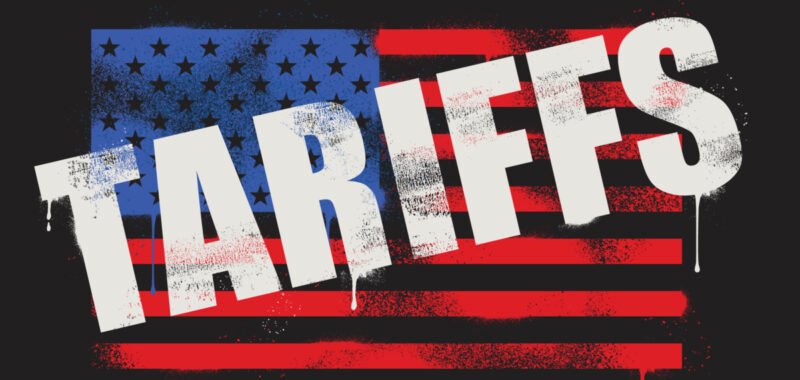After two fantastic years, the stock market entered a whole new phase in recent times: one of turmoil. The S&P 500 index and the Dow Jones Industrial Average have slipped so far this year, and the Nasdaq Composite even crashed into a bear market earlier this month — though indexes have recovered from their lowest points. The reason for the declines and volatility? Investors are worried about President Donald Trump’s plan to tax imports and the result this may have on the economy.
Technology stocks have been particularly sensitive to tariff news since they’re known for manufacturing a great deal of their products abroad. Though Trump has exempted electronics from the tariffs, he said this exemption is temporary as his administration studies specific tariff levels for the industry. These tariffs probably will come in a month or so, U.S. Commerce Secretary Howard Lutnick said during a recent ABC interview earlier this month.
So, it seems likely that technology companies will face higher costs in the near future. How risky does this make tech stocks right now?

Image source: Getty Images.
The tariff situation
It’s important to consider the entire tariff situation (I’m writing of this article in the morning on April 23). The president earlier this month launched a broad plan taxing imports from countries worldwide at various levels, but he then pressed the pause button on this to allow 90 days for countries to negotiate with the U.S. Meanwhile, he maintained a baseline 10% tariff level on most countries. At the same time, he also maintained a 145% tax on imports from China. But the exemption on electronics means tech companies like Apple (NASDAQ: AAPL), at least for now, can continue to manufacture in China and then import to the U.S. without paying these duties.
In recent days, Trump has said the tariffs on China will come down from the current level, and according to a Wall Street Journal report, a White House official said the U.S. may decrease the tariff level to the range of 50% to 65%. The U.S. hasn’t yet spoken of tariff levels for electronic imports from China or other countries.
In terms of exposure to the tariffs, this varies from company to company. For example, Nvidia (NVDA 3.86%) is heavily exposed to Taiwan, where it manufactures most of its chips, though the company is trying to increase chip production in the U.S. Apple has expanded its manufacturing locations into countries such as India and Vietnam, but it still relies most heavily on China.
Exposure varies from company to company
And certain tech companies are less exposed to tariff pressures. Though Meta Platforms produces some products abroad and relies on chips from others that are made outside of the U.S., the company’s main revenue driver is its social media platform — advertisers pay to reach users of social media. So Meta may suffer less than a player known primarily for producing hardware. This means it’s important to study companies on a case-by-case basis when considering how the tariffs may affect them.
Still, it’s fair to say that most tech companies would face some headwinds from tariffs — and the cost structure of many relies on their ability to produce goods internationally.
Now, let’s talk about risk. Of course, a lot of uncertainty exists right now because we don’t know the exact tariff levels tech companies will face. I t’s impossible to predict how the tariffs will impact costs. It’s also important to consider that tariffs on other goods also play a role in tech companies’ growth prospects. If tariffs hurt the consumer and the general economy, demand for certain tech products could decline and therefore weigh on earnings.
Measuring the risk
All of this means that, unless Trump completely changes his mind about tariffs, tech companies will feel some pressure once the final plan is set in motion. So, the risk today is the fact that we don’t know the exact tariff levels or how they will impact costs and demand for tech products. This means there is some risk to investing in tech stocks, though it wouldn’t be enough to stop me from buying them. (However, I’m talking about strong tech players with established track records. Companies with weak competitive positions or those that are struggling financially would be very high risk right now.)
Tech leaders, such as Nvidia and many others, have proven their ability to manage crises and grow earnings over time. These quality players are nimble to a certain degree and have the ability to deal with unexpected costs or challenges. At the same time, it’s unlikely that the U.S. would impose a plan that would destroy its most powerful companies.
All of this means there is a risk tech companies will see temporary pressure on earnings, but I don’t expect this to change their long-term prospects. So now is a great time for tech investors to go bargain hunting and pick up some beaten-down leaders to hold onto for the long run.
Randi Zuckerberg, a former director of market development and spokeswoman for Facebook and sister to Meta Platforms CEO Mark Zuckerberg, is a member of The Motley Fool’s board of directors. Adria Cimino has no position in any of the stocks mentioned. The Motley Fool has positions in and recommends Apple, Meta Platforms, and Nvidia. The Motley Fool has a disclosure policy.

